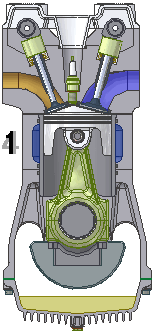 The valve train refers to the assembly of components designed to open and close the intake and exhaust valves. Most new engines have overhead cam assemblies. Assuming you already understand the four stoke cycle, (navigate here if you don’t) this post will be discuss about the mechanism used to open and close each valve. In the moment of the piston moving up and down completing their cycle, valvetrain play their role ensuring the desired strokes successfully done. Aiming the goal, this mechanism built by few parts and devices which are relied on each other ensuring the accuracy and synchronization among those element. Common valve system will be assembled by:-
The valve train refers to the assembly of components designed to open and close the intake and exhaust valves. Most new engines have overhead cam assemblies. Assuming you already understand the four stoke cycle, (navigate here if you don’t) this post will be discuss about the mechanism used to open and close each valve. In the moment of the piston moving up and down completing their cycle, valvetrain play their role ensuring the desired strokes successfully done. Aiming the goal, this mechanism built by few parts and devices which are relied on each other ensuring the accuracy and synchronization among those element. Common valve system will be assembled by:-Open and closed at desired timing. Each cylinder has at least one intake valve (1) and one exhaust valve (2). Some engines are designed with two sets of valves per cylinder as shown in the photo. The intake valve has a larger diameter than the exhaust valve, which maximizes air flow to the cylinder. The exhaust valve must withstand higher temperatures than the intakevalve since the air flowing past the intake valve keeps the intake valve at a lower temperature. However, both intake and exhaust valves must transfer their heat to the cylinder head otherwise they will burn.


The valve are supported by:
a. Valve seal
Preventing any leakage at the valve guide.
b. Valve keeper (locks)
Secure the valve by clamping valve groove.
c. Valve spring
Used to lock the valve in its place and ensuring the valve closed in closed position
d. Spring retainer
Hold the spring from bounce out and transfer the spring forces to retainer sleeve
e. Retainer sleeve
The spring retainer is designed to hold in place the valve stem tip. This allows the rocker arm to act directly on the valve and transfer spring force to valve keeper.
f. Valve guide
Ensure accurate valve movement.
g. Tappet screw
Giving variable tolerance to the valve timing.
Transfer camshaft force to poppet valve.3) Camshaft
Provide the force for opening valves. We will go details on thispart later as camshaft determine the lift, timing and duration
of a valve opening.
4) Cam wheel
Receive rotational forces from timing chain or timing belt.5) Crankshaft
Convert the linear motion of piston power stroke into rotational motion.6) Crank wheel
intake and exhaust camshafts. The chains are located on the
engine's front end, and are pulled by a crank wheel (1), which
is turned by the engine's crankshaft. Timing chains are
required for both the intake cam wheel (2) and the exhaust
cam wheel (3). A chain guide (4) is also provided. Some engines
still use belts instead of chains. In either case, excess slack or
play will degrade engine performance.
Well, those are the part that consist in general four stroke systems. However, it’s still depends on their design some manufacturer might used other system while other change few above parts with others Looking back to the previous post you should see while the crankshaft rotates the cam also rotate and opening the valve. And yes, that system doesn’t use rocker arm since the cam directly in contact with valve tip. If you can figure out, the each valve only opens once in two crankshaft rotation. This shows that the ratio of crankshaft to camshaft rotation is 2:1. This ratio is controlled by the crank wheel and cam wheel as it will determine the timing and synchronization between valves movements and pistons strokes. The crucial element is to ensure that each valve only open once so that the four stoke cycle could be carried out.





Nice to read your post based on Valvetrain. Here I got maximum information which is too beneficial for me. I can say this post is best to know about Valvetrain.
ReplyDeleteexhaust valves